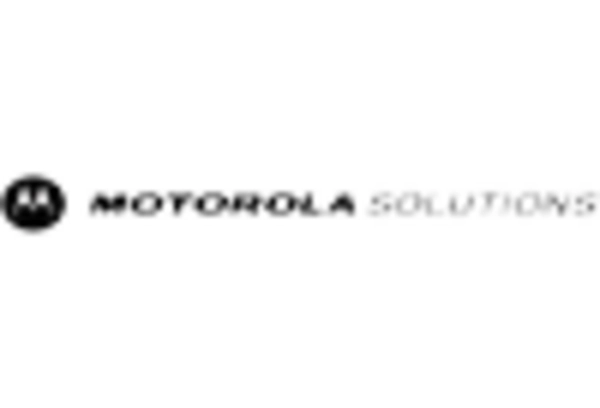Rising Cybersecurity Concerns
The escalating concerns regarding cybersecurity threats are becoming a pivotal driver for the lte critical-communication market. As critical communication systems become more interconnected, the potential for cyberattacks increases, prompting organizations to prioritize security measures. In Europe, the implementation of stringent cybersecurity regulations is influencing the adoption of secure LTE solutions. The market is expected to see a surge in demand for secure communication technologies, with investments in cybersecurity measures projected to reach €5 billion by 2026. This focus on security is likely to drive innovation within the lte critical-communication market, as providers develop solutions that not only meet communication needs but also address security vulnerabilities. Consequently, organizations are compelled to invest in advanced security protocols to safeguard their communication infrastructure.
Regulatory Support and Standardization
Regulatory frameworks and standardization efforts play a crucial role in shaping the lte critical-communication market. In Europe, various governmental bodies are actively promoting the adoption of LTE technology for critical communications. Initiatives such as the European Telecommunications Standards Institute (ETSI) are working towards establishing guidelines that ensure interoperability and security across different communication systems. This regulatory support is likely to enhance market growth, as it provides a clear pathway for organizations to adopt LTE solutions. Furthermore, the European Union has allocated substantial funding to support the transition to advanced communication technologies, which is expected to bolster the lte critical-communication market. The alignment of regulations with technological advancements may facilitate smoother implementation and encourage investment in critical communication infrastructure.
Growing Demand for Reliable Communication
The increasing need for dependable communication systems in emergency services and public safety is a primary driver for the lte critical-communication market. As urbanization accelerates, the complexity of managing public safety increases, necessitating robust communication solutions. In Europe, the market is projected to grow at a CAGR of approximately 15% from 2025 to 2030, driven by the demand for seamless communication during crises. This growth is further fueled by the integration of LTE technology, which offers enhanced voice and data capabilities. The lte critical-communication market is responding to this demand by developing solutions that ensure uninterrupted connectivity, even in challenging environments. As a result, stakeholders are investing in advanced infrastructure to support these requirements, indicating a strong trend towards prioritizing reliable communication systems.
Increased Focus on Public Safety Initiatives
The heightened emphasis on public safety initiatives across Europe is significantly influencing the lte critical-communication market. Governments are increasingly recognizing the importance of effective communication systems in ensuring public safety, particularly in the wake of natural disasters and security threats. This focus has led to the allocation of substantial budgets for upgrading communication infrastructure, with estimates suggesting that public safety budgets could reach €10 billion by 2027. The lte critical-communication market is poised to benefit from these investments, as agencies seek to implement advanced communication solutions that enhance situational awareness and response times. The integration of LTE technology into public safety operations is likely to improve coordination among various agencies, thereby fostering a more efficient response to emergencies.
Technological Advancements in Communication Systems
Technological advancements are driving innovation within the lte critical-communication market. The introduction of next-generation LTE solutions, such as Mission-Critical Push-to-Talk (MCPTT) and enhanced multimedia services, is transforming how emergency services operate. These advancements enable real-time data sharing and improved communication capabilities, which are essential for effective crisis management. In Europe, the market for MCPTT is expected to grow significantly, with projections indicating a rise to €1.5 billion by 2028. This growth is indicative of the increasing reliance on advanced communication technologies to support critical operations. As organizations adopt these technologies, the lte critical-communication market is likely to witness a shift towards more integrated and efficient communication systems, enhancing overall operational effectiveness.


















Leave a Comment